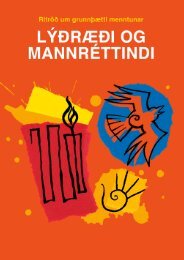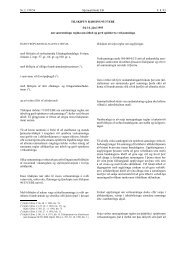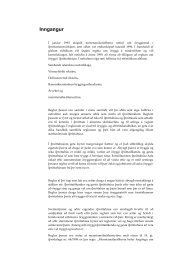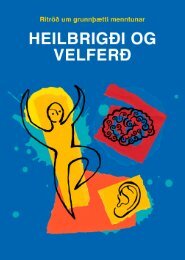Arts and Cultural Education in Iceland : Professor Anne Bamford
Arts and Cultural Education in Iceland : Professor Anne Bamford
Arts and Cultural Education in Iceland : Professor Anne Bamford
Create successful ePaper yourself
Turn your PDF publications into a flip-book with our unique Google optimized e-Paper software.
There are 300 hundred pupils <strong>in</strong> this school aged between 16 <strong>and</strong> 20 years, of this 100 pupils <strong>and</strong> roughly a third<br />
of the school takes the art l<strong>in</strong>e. There are 90 pupils this semester tak<strong>in</strong>g the art l<strong>in</strong>e. The art l<strong>in</strong>e is available to<br />
everybody <strong>in</strong>clud<strong>in</strong>g students with special needs. There are students apply<strong>in</strong>g to a full range of universities. There are<br />
roughly 20 students <strong>in</strong> the visual arts l<strong>in</strong>e <strong>and</strong> 15 <strong>in</strong> the textiles l<strong>in</strong>e <strong>and</strong> also a range of electives that can be taken<br />
over two years.<br />
Students take the art l<strong>in</strong>e alongside their matriculation l<strong>in</strong>e. Most students take around three years to complete<br />
the qualification. Currently there are only two teachers <strong>in</strong> art. The arts course covers basic visual arts, draw<strong>in</strong>g,<br />
pa<strong>in</strong>t<strong>in</strong>g, colour <strong>and</strong> form, art <strong>and</strong> culture. There is also an art history course <strong>and</strong> this is available via distance learn<strong>in</strong>g,<br />
<strong>and</strong> also graphics <strong>and</strong> architecture. They can choose the l<strong>in</strong>e that suits them.<br />
We do some history of design <strong>and</strong> we work <strong>in</strong> collaboration with other courses via onl<strong>in</strong>e learn<strong>in</strong>g <strong>in</strong> particular<br />
students <strong>in</strong> the <strong>in</strong>formation <strong>and</strong> media course chose some of our electives. In particular, those <strong>in</strong> the media like to<br />
undertake arts courses. For example we currently have seven students that are do<strong>in</strong>g design via distance learn<strong>in</strong>g. We<br />
started collaborat<strong>in</strong>g with three other schools <strong>and</strong> we focus on textiles. We followed an exist<strong>in</strong>g curriculum <strong>and</strong> we<br />
also do the basic l<strong>in</strong>e for tailors <strong>and</strong> for adults. We encourage designers who have graduated from our course to come<br />
back <strong>and</strong> talk to the students. We also encourage our students to be active <strong>in</strong> design projects such as design<strong>in</strong>g for the<br />
school play.<br />
The school has a strong culture of art throughout the school <strong>and</strong> the students do a lot of art activities outside the<br />
school. Personally I th<strong>in</strong>k it would be better if we could open th<strong>in</strong>gs up a bit. Open to students of all different<br />
backgrounds <strong>and</strong> all different types of students that way we would be able to get students from wider horizons. We<br />
have less money this year so th<strong>in</strong>gs have to be smaller.<br />
They’re also chang<strong>in</strong>g a policy <strong>and</strong> we are concerned about what the future will br<strong>in</strong>g. I wanted to mix the<br />
discipl<strong>in</strong>es but so far that’s not been possible. I only got half the fund<strong>in</strong>g I’d asked for, the fund<strong>in</strong>g is only about<br />
30million ISK per year, but I would do it anyway. I’ll have to make do. We’ve all got less money <strong>in</strong> this country. But I’ll<br />
survive because of help from the community, but I’ll have to do it differently. I’m look<strong>in</strong>g at programmes of cultural<br />
cooperation. We have one already with Irel<strong>and</strong> <strong>and</strong> another one with Norway. I th<strong>in</strong>k basic art <strong>and</strong> design courses give<br />
a good <strong>in</strong>troduction to different sorts of courses. We have basically four cultural centres; visual arts, theatre, literature<br />
<strong>and</strong> music..<br />
We encourage artists <strong>in</strong> residence. These come from other parts of the world, currently from Irel<strong>and</strong>. We also can<br />
send our students to Irel<strong>and</strong> as part of a cooperation. I recently sent students to a visual arts festival. I’ve tried to f<strong>in</strong>d<br />
opportunities for our students to work with other students, so their work is not so isolated. For example, students<br />
from Arizona, Norway <strong>and</strong> Irel<strong>and</strong> worked together to produce a short film. We also made an exhibition of 100 artists<br />
of stills. Basically, you get 20 hours a week for one unit.<br />
We have a very flexible structure. We have a lot of visit<strong>in</strong>g artists <strong>and</strong> there is a youth house which we<br />
collaborate with. It is an old slaughter house which is now a youth centre <strong>and</strong> a cultural house. We hold exhibitions<br />
there. The students are go<strong>in</strong>g to Sicily for two weeks to have an experience. We do this through a project. They have<br />
to pay 1500 euro each but we’ll write a report <strong>and</strong> put some articles onl<strong>in</strong>e. We can’t go every year on visits because<br />
the students can’t afford to pay. We are very proud of this department <strong>and</strong> th<strong>in</strong>k it is important <strong>in</strong> the community too.<br />
We do a lot of work with the town centre <strong>and</strong> festivals; there are a lot of festivals.<br />
1.12Music Schools<br />
‣ Icel<strong>and</strong> has an extensive system of local government funded after school music schools<br />
‣ Attendance at Music Schools is comparatively lower <strong>in</strong> adolescence<br />
‣ The curriculum of Music Schools is generally based on classical music <strong>and</strong> traditional<br />
<strong>in</strong>strumental <strong>in</strong>structional approaches<br />
‣ Music schools should work more closely with their local compulsory school(s)<br />
‣ Further research needs to be undertaken on the impact of group or <strong>in</strong>dividual tuition<br />
on musical <strong>in</strong>strument <strong>and</strong> vocal learn<strong>in</strong>g on pupils, attendance, enjoyment <strong>and</strong><br />
quality of learn<strong>in</strong>g<br />
‣ Effects of changes <strong>in</strong> affordability of music school lessons needs to be monitored to<br />
ensure there is not an adverse impact on attendance or accessibility<br />
Icel<strong>and</strong> has an extensive network of after school arts schools. There are two ma<strong>in</strong> types of<br />
out of school provisions. The first are music schools offer<strong>in</strong>g substantial <strong>in</strong>strumental <strong>and</strong>/or<br />
35



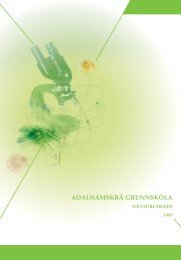
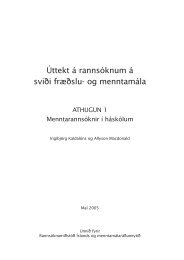

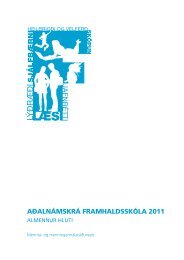
![Aðalnámskrá tónlistarskóla : rytmÃsk tónlist [Eingöngu á rafrænu formi]](https://img.yumpu.com/50843672/1/184x260/aaalnamskra-tanlistarskala-rytma-sk-tanlist-eingangu-a-rafranu-formi.jpg?quality=85)
